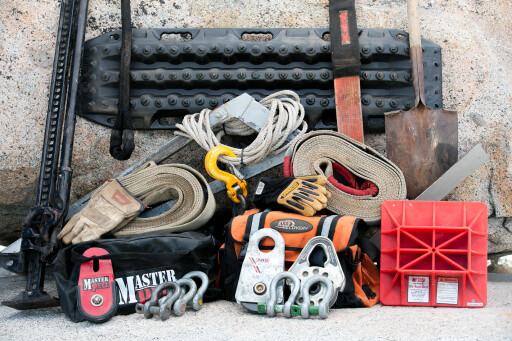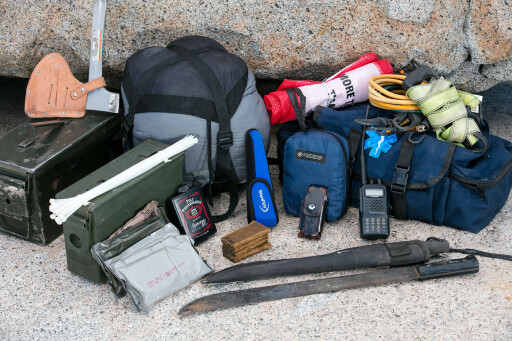
If we sat around a campfire spinning yarns about our early exploits into the backcountry, my guess is that the memories, regardless of the details, have been filtered into blissful adventures. They were most likely simple affairs with a full complement of necessities: a cooler of coldies, sleeping bags and camp chairs.
I recall the first trip in my ’82 Hilux. My buddy Rich Currie and I blazed out of town one afternoon, bent on exploring a place called South Fork. The route, a muddy three-mile trench, was a good distance from the pavement and we had the place to ourselves. All was good until I buried the truck to its frame and realised the cooler lid made a poor digging implement. We survived, but the takeaway was that I should pack a shovel next time.
During the next adventure, a friend became mired in axle-deep snow. I attempted to pull him out with an old rigging rope, which immediately broke. Another takeaway… I needed to buy a recovery strap. A year later, the radiator and fan of a friend’s Jeep did the tango. I watched as the “old guys” in my club resuscitated the radiator with needle-nose pliers and coarse-ground pepper. Yet more to add to my toolbox: pliers and pepper.
What do you carry in your 4x4 toolbox? Specifically, what tools, spare parts, recovery gear and specialty items do you carry that might help you (and your rig) get home alive.
 When it comes to self-supported travel, developing a list of what items to bring and what to leave at home can be daunting. After 35 years of takeaways, I suggest crafting one around your personal style of travel. If you favour day trips and staying in campgrounds a short distance from services, a basic recovery kit and tools may be all you need. However, if you pine for the road less-travelled and pitching your tent in the loneliest of locales, a detailed evaluation is in order.
When it comes to self-supported travel, developing a list of what items to bring and what to leave at home can be daunting. After 35 years of takeaways, I suggest crafting one around your personal style of travel. If you favour day trips and staying in campgrounds a short distance from services, a basic recovery kit and tools may be all you need. However, if you pine for the road less-travelled and pitching your tent in the loneliest of locales, a detailed evaluation is in order.
Things to consider should be the age and condition of your vehicle, your mechanical skills and available storage space. At the end of the day, packing a vehicle’s suitcase is akin to sorting out personal items for a big trip. Lay out everything you think you’ll need, determine what will fit, prioritise, and cull the items at the bottom.
To simplify things, I’ve broken the process into several categories: recovery, tyre surgery, spares, standard and specialty tools, welding kit, fluids, and go-to backcountry gear. Don’t feel compelled to stuff everything on my list in your rig, simply use it as a guideline.
In Part 1 we will cover the basic essentials in the form of the Recovery Suitcase and Basic Backcountry Kit Suitcase.
Recovery Suitcase
When asked about the first modification someone should make to a vehicle, my answer is always to source a quality recovery kit. The basics should include a kinetic energy recovery rope (KERR) or snatch strap, two rated screw-pin bow shackles and gloves. If the vehicle is equipped with a winch, a winch line damper, pulley block, tree saver and additional bow shackles should be included. For advanced winching operations and remote travel, add a winch line extender (50-foot minimum), another pulley block, plus additional snatch and utility straps.
 It is important that all components in a winching system have a working load rating (WLL) no less than twice that of the winch. I should clarify the difference between WLL and minimum breaking load (MBL). The stated WLL includes a safety factor that is usually 1/4 to 1/6 the MBL. For example, I have several Van Beest Green Pin shackles, which have a WLL of 4.75 tons and a safety factor of 6x (MBL of 28.5 tons). Think about this when reviewing the vehicle-to-vehicle recovery tip below.
It is important that all components in a winching system have a working load rating (WLL) no less than twice that of the winch. I should clarify the difference between WLL and minimum breaking load (MBL). The stated WLL includes a safety factor that is usually 1/4 to 1/6 the MBL. For example, I have several Van Beest Green Pin shackles, which have a WLL of 4.75 tons and a safety factor of 6x (MBL of 28.5 tons). Think about this when reviewing the vehicle-to-vehicle recovery tip below.
Without getting into a long dissertation on safety, be certain that every component has the appropriate WLL and MBL for a given use and is in good condition. Personal experience has taught me that a system failure under load can be disastrous. Takeaway: a chain is only as strong as its weakest link.
Recovery Suitcase Must-Haves:
A comprehensive recovery kit should include a Hi-Lift jack and base, Pull-Pal, MaxTrax, recovery straps (2), tree protectors (2), 50-foot winch line extender, screw-pin bow shackles (5), pulley blocks (3), shovel, and gloves.
Chris' Recovery Tips:
1 - Introducing a pulley block to a winching system can double WLL on some components.
2 - During a vehicle-to-vehicle snatch recovery, the kinetic energy developed by a 5000-pound vehicle moving at 15mph is 34,485 ft-lb.
3 - Evaluate WLL and MBL prior to purchasing recovery equipment.
Chris' Recovery Suitcase Pack List:
Statch straps (2)
Tree protector
Winch line extender
Winch line damper/sail
Pulley block (2)
Bow shackles (4-6)
Gloves (heavy-duty)
Pull-Pal
MaxTrax
Shovel
Basic Backcountry Kit Suitcase
While most of the items listed here may seem obvious, I’m surprised at the number of people I meet on the tracks with only a cooler of drinks (me, 30 years ago).
I’ve heard people say Hi-Lift jacks are bulky and dangerous, rubber gloves are for wimps, and that they don’t need “all that other mumbo jumbo.” I agree that a Hi-Lift is heavy, can be dangerous if not used properly, and will pulverise anything in its path if stored improperly.
 However, it is on my Top 10 list of must-have tools of the trade. It can be used to realign an axle housing or broken frame, as a press, wood splitter, to reposition the cab of a rolled vehicle, and yes, it can even lift a vehicle. Ratchet straps, bungee cords, and zip ties are three of the Seven Wonders of the trail. An axe, shovel, machete, and the rest are all commonsense basics.
However, it is on my Top 10 list of must-have tools of the trade. It can be used to realign an axle housing or broken frame, as a press, wood splitter, to reposition the cab of a rolled vehicle, and yes, it can even lift a vehicle. Ratchet straps, bungee cords, and zip ties are three of the Seven Wonders of the trail. An axe, shovel, machete, and the rest are all commonsense basics.
Another handy addition is nitrile rubber gloves. They are a must when you need to drop greasy parts and want a clean hand to grab a sandwich. As for spare metal plating and hardware, they come in handy for patching up the aforementioned broken parts (these will save you from using expensive tools as filler material).
This list may be a bit intimidating, but I gathered much of it from hanging around old Jeepers driving Willys CJ-2As and CJ-5s (and they made it all fit). Takeaway: rubber gloves... so I’m a wimp!
Backcountry kit Essentials:
There are a host of items that should be carried in your vehicle. The list includes an axe, saw, sleeping bag, poncho, water filter or purifier, handheld UHF radio, medical kit, hot wood and lighter, trash bag, zip ties, bungee cords, ratchet straps, food rations, and a flask of your favourite spirits.
Chris' Backcountry Kit Advice:
1 - Basic equipment should be in your vehicle at all times.
2 - Hi-Lift jacks, ratchet straps and bungee cords are amazing.
3 - Carry a selection of metal and hardware for major repairs.
Chris' Backcountry Pack List:
Hi-Lift jack and base
Axe
Shovel
Saw
Machete
Bungee cords, ratchet straps,
zip ties
Rigging rope and paracord
Collapsible bucket
Jumper cables
Fire extinguisher
Tyre iron (4-way star type)
Mac’s Tiedowns utility mat
Safety glasses
Nitrile rubber gloves
Medical kit
Flares
Bug repellant
Canteen, water filter or tablets
Compass
Extra food (three-day supply)
Flask of spirits (your choice)
Flashlight/headlamp (extra
batteries)
Sleeping bag for each occupant
Fuel sticks (fat wood)
Waterproof matches
Knife and multi-tool
Spare ignition key
Sunscreen
Toilet paper
Biodegradable soap
Baling wire
Duct tape
Ziploc bags
Shop rags
Hardware (various sizes)
Metal flat bar, angle iron
Tarp
Poncho

COMMENTS